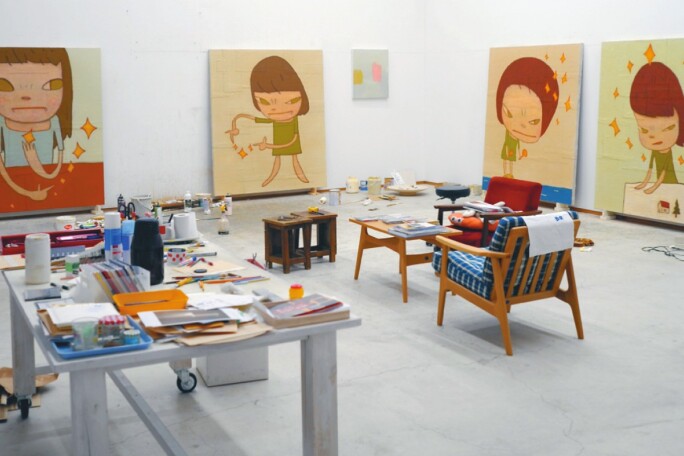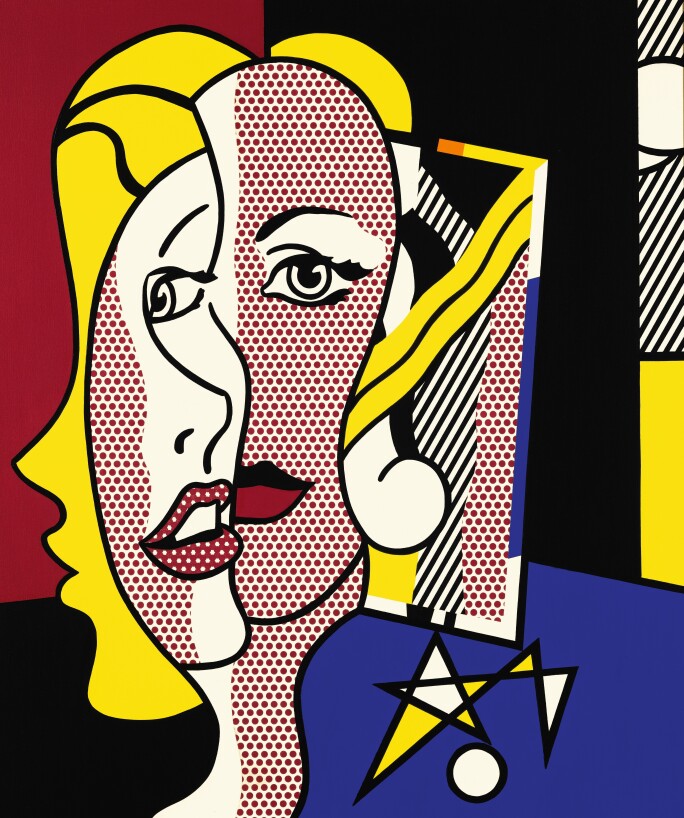Nara captures the tension between the innocence and experience, physical isolation and mental freedom, containment and independence. Nara embraces the whole of the human condition and recognizes that, in fact, evil is an essential part of innocence.

本作品在藝術家工作室
Iconic, endearing, exuding a whimsically enchantingly aura, Ten Stars from 2014 is one of four works from a special series by Yoshitomo Nara executed in burlap and foregrounding the motif of stars. Ten gold four-point stars swirl like a halo around our petite heroine, whose prickly piercing sideways glare dares us to question what magic or mischief she’s plotting. In the series of only 4 paintings, of which the present work features the most number of stars, Nara focuses for the first time specifically on stars imagery – a motif that is simple yet laden with associations, charged with instant resonance and appeal, and which concocts boundless room for imagination. The combination of Nara’s intricately constructed patchwork of jute and exquisitely applied brushwork typifies the artist’s deceptively simple aesthetic, which conceptualizes the sullen, insolent yet adorable young girl as a paradigm for the disaffection of Japanese youth: here, the titular ten stars represent the magically insurgent power of children and the radical, rebellious potentiality of the marginalized and the imagined. Meanwhile, the small toy house and tree on the bottom of the composition harken to childhood, solitude and innocence; as with the very best of Nara’s output, the present work combines the artist’s two most important archetypes – the rebel youth and the lonely child.

羅伊·李奇登斯坦,《女頭》,1977年作
Born in 1959 in Hirosaki in the Aomori Prefecture, Nara’s formative years were marked—if not marred—by intense feelings of isolation: born to emotionally distant workaholic parents in post-war Japan and growing up as the youngest of three sons by a drastic age difference, Nara’s childhood was for the most part spent alone. The artist once admitted in an interview: “When you are a kid, you are too young to know you are lonely, sad, and upset… Now I know I was”. Transforming his intense feelings into art, Nara immortalized his loneliness in portrait after portrait of young solitary children set against barren backgrounds, building a distinctive yet highly accessible oeuvre that quickly gained an explosive worldwide cult following. His endearing creations fuse anime, Pop Art and punk rock, combining mischief and innocence to convey a beguiling sugary sweetness on the surface that melts to reveal darker angsts. While immediately reminiscent of Pop and exuding an undeniable Lichtenstein-esque vibe, the artist’s reductive figurations draw also on Modernism’s sign-like shorthand language of images to leaving endless space for fantasy for the child as well as adult viewer. Formally, his works also evoke traditional Japanese forms from the East, such as Japanese u-kiyo woodcut; as Stephan Trescher writes, “[…] the full-body portrait in front of a neutral background, the relationship between figure and the picture plane, the image-object and the empty surrounding space, the connection between the image sign and the text sign, the blurring of the boundary between printmaking and painting – all can be found in Nara’s art as well as in colored prints from the 18th and 19th centuries by Hiroshige, Hokusai or Utamaro” (Stephan Trescher, “A Portrait of the Artist as a Young Dog”, in Yoshitomo Nara: Lullaby Supermarket, Michael Zink Gallery, Munich, 2002, p. 11).
Executed on jute and mounted on board, and with the featuring of the sign-like motifs of the four-point stars, the present work in particular displays stylistic affinities with Japanese ukiyo-e woodcut. Ten Stars represents the culmination of decades of artistic developments, which encompassed forays into sculpture in different mediums, painting on cotton and linen, and in the late 2000s onwards, a more meticulous, meditative and introspective style of brushwork, communicating heightened expression with line and colour. In the artist’s own words: “In the past I would have an image that I wanted to create, and I would just do it. I would just get it finished. Now I take my time and work slowly and build up all these layers to find the best way” (the artist cited in Robert Ayers, “‘I Was Really Unthinking Before’: Yoshitomo Nara on His Recent Work and His Show at Pace Gallery in New York”, Artnews, 14 April 2017). Elsewhere Nara observes how his methodology has become increasingly introspective, noting that: “When I work this way there’s a lot more of a conversation that I have with the image, or with the person who’s depicted in the image. That’s really me having a conversation with myself. It allows me to draw out parts of myself that I’m not even aware are there” (the artist cited in ‘Japanese artist has a taste for Hong Kong’, South China Morning Post, 9 March 2015).

奈良美智,《三顆星》,2014年作,香港,蘇富比 ,2020年7月9日 售價:28,975,000 港幣 (3,736,906 美元)
Much like his characters, Nara’s fragile vulnerability is paralleled with a gallant rebellious streak; the famously soft-spoken artist was once arrested for drawing graffiti in New York’s Union Square underground. Conceptually, the artist’s oeuvre can be seen as “both a detached commentary on the pressures of Japanese adolescence and a symptom of it” (David McNeill, "Yoshitomo Nara: neo-pop artist who defies categorisation", South China Morning Post, March 5, 2015); while his revolutionary aesthetic constitutes a seamless unification of Eastern and Western themes and motifs. In American critic Roberta Smith’s words, Nara is “one of the most egalitarian visual artists since Keith Haring”, with art that bridges “high, low and keitsch; East and West; grown-up, adolescent and infantile” and is “so seamless as to render such distinctions almost moot” (Ibid). The artist himself says: “I don’t think too hard about it. This is just what comes out” (Ibid).
Fashioned in flawless execution with beguiling texture that approaches a sculptural quality, Ten Stars presents an instantly compelling and iconic image that ranks amongst the most exemplary of Nara’s larger-than-life oeuvre.
「奈良展現出天真與世故、肉體孤獨與精神自由、受制於人與獨立自主之間的張力。他看到人類普遍的生存境況,並承認無邪本質上其實包含邪惡。」
完成於2014年的《十顆星》是奈良美智筆下受人喜愛的典範之作,氣質精靈趣怪。它來自一個只包含四幅作品的特別系列,此系列以粗麻布為媒材,在奈良以星為題的作品中顯得尤其奪目。畫中的女孩嬌小玲瓏,身旁環繞著十顆四角星,她怒目視斜,彷彿向觀眾擲下戰書,看我們是否膽敢質疑她所施展的法術或密謀的搗蛋大計。《十顆星》在其所屬系列中擁有數量最多的星星,奈良在繪畫本作時首次集中強調星星這個意象——此題材看似簡單但寓意豐富,容易引發共鳴和欣賞之情,構築出無限的遐想空間。畫家採用細織黃麻畫布,並運用純熟細膩的筆觸,呈現出美學風格貌似簡單、實則展現日本青少年叛逆特質的小女孩形象,她慍怒寡歡,傲慢粗魯,但仍惹人憐愛;作品標題所指的十顆星代表孩童和激進社群顛覆世界的力量,以及邊緣和虛構人物的反叛潛力。畫面下方的玩具小屋和小樹迴盪著童年的足音,孤獨而純真。本作一如奈良的其他大師級傑作,將叛逆青年和寂寞孩童——奈良筆下兩個最重要的原始形象合而為一。
奈良美智在1959年生於日本青森縣弘前市,兒時的孤獨和失落感在他心中留下深刻的烙印,成年後這些回憶依然反覆浮現。他成長於戰後日本,父母長年忙於工作,與子女感情疏離,而且他是家中排行最小的第三子,與兄長年紀相差甚遠,因此他的童年幾乎是獨自一人度過。奈良曾在一次訪談中坦言:「兒時還太小,不知道自己是孤獨、悲傷、苦惱的……現在卻明白當時自己的心境就是那麼一回事」。他把強烈情感投放在藝術之中,無數幅畫像中的小孩都是孤零零地處在一片模糊空虛的背景中。他的作品流露著一股揮之不去的孤獨情緒,在世界各地驟獲廣泛迴響。奈良的畫風簡練單純,融入動畫、普普藝術和朋克搖滾元素,女孩調皮天真的可愛面目下暗藏焦慮不安。他的作品是日本普普藝術的代表之一,明顯受李奇登斯坦的表現手法影響;簡潔的人物造型源於現代主義,圖像猶如一段簡略的速記語言,留給兒童以至成年觀眾無窮的想像空間。其作品的構圖方式亦受傳統日本畫影響,例如浮世繪木版畫。正如史提芬・特里沙所言:「……空無一物的背景上的全身人物,人物與平面、圖像與周邊空白的關係,圖像與文字的關聯,印刷和繪畫之間界限的模糊——這一切都出現在奈良美智和十八、十九世紀歌川廣重、葛飾北齋和喜多川歌麿等浮世繪畫師的創作中」(史提芬・特里沙撰,〈藝術家的一幅自畫像:一頭幼犬〉,載於《奈良美智:搖籃曲超市》展覽圖錄,Michael Zink Gallery,慕尼黑,2002年,頁11)。
本作採用黃麻畫布,裱於畫板之上,畫中的四角星有如符號,在風格上與日本浮世繪木版畫同出一脈。《十顆星》匯聚了奈良數十年的創作發展成果,其中包括嘗試用不同媒材做出雕塑、在棉布和麻布上繪畫。奈良的筆風在千禧年後期更趨精細,一筆一畫和每處用色皆流露出畫者的深思熟慮。用藝術家自己的話說:「從前,如果我有一幅想創作的畫作,我會立刻執筆,直至完成。現在,我會花時間慢慢畫,層層遞進,務求找到最好的方式」(引述自羅伯特・艾爾斯撰,〈我以前真的缺乏思考:奈良美智談近作及紐約佩斯畫廊展覽〉,《藝術新聞》,2017年4月14日)。他觀察到自己的創作方法變得更為內省:「當我這樣繪畫時,我便能與畫面圖像或圖像中所描繪的人物有更多交流。這其實是我跟自己的個人對話。它讓我畫出一部份自我,甚至連我都不知道它們的存在」(引述自藝術家,〈日本藝術家對香港情有獨鍾〉,《南華早報》,2015年3月9日)。
奈良美智生性既脆弱敏感,卻又叛逆敢行,一如他創造的人物。這位溫和安靜的藝術家曾經因為在紐約聯合廣場地鐵站塗鴉而被捕。他的創作可以說是「對日本青少年背負的壓力的冷靜旁觀表述,同時也是其中一份子」(大衛・麥尼爾,〈奈良美智:拒絕分類的新普普藝術家〉,《南華早報》,2015年3月5日) 。他的畫風顛覆傳統的審美標準,完美糅合東西方的藝術主題和概念。誠如美國藝評人蘿伯塔・史密斯所言,奈良美智是「自凱斯・哈林以來最接近平等主義的視覺藝術家之一」,他的藝術「連接高級(藝術)、低級(藝術)以及媚俗,東方與西方,成年人、青少年和幼童」,「漫不經意地將這些界別消除殆盡」(同上)。 藝術家卻自言:「我沒有想太多。這都是自然而生的結果」(同上)。《十顆星》集無懈可擊的演繹手法與近乎雕塑的迷人肌理於一身,涵義深刻且引人入勝,無疑是奈良巨幅作品中的經典。